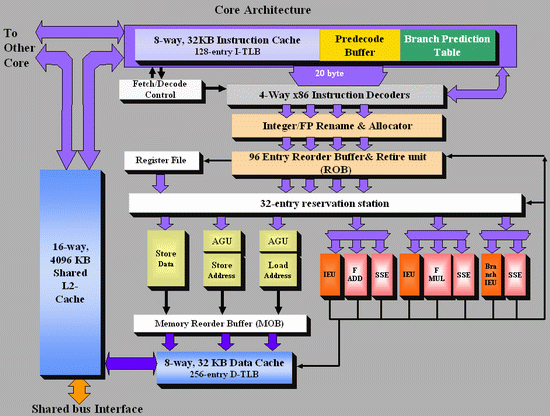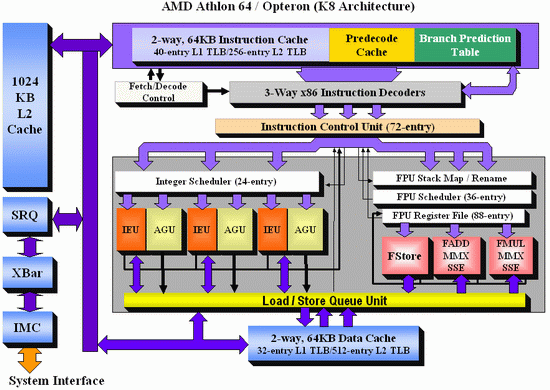Out of Order execution: AMD versus Intel
To make this article more accessible and to make the differences between the AMD K8 and the new Intel Core architecture more clear, I tried to make both CPU diagrams in the same style. Here's the Core architecture overview:
And here's the K8 architecture:

There are a few obvious differences: Core has bigger OoO buffers: the 96 entry ROB buffer is - also thanks to Macro-op fusion - quite a bit bigger than the 72 Entry Macro-op buffer of K8. The P6 architecture could order only 40 instructions, this was doubled to 80 in the P-M architecture (Banias, Dothan, Yonah), and now it's increased even further to 96 for the Core architecture. We've created a table which compares the most important architectural details of several current CPU families:
 |
| Click to enlarge |
The Core architecture uses a central reservation station, while the Athlon uses distributed schedulers. The advantage of a central reservation station is that utilization is better, however distributed schedulers allow more entries. NetBurst also uses distributed schedulers.
Using a central reservation station is another clear example of how Core is in fact the "P8", the second big improvement of the P6 architecture. Just like the P6 architecture, it uses a Reservation Station (RS) and allocates a specific execution unit to execute the micro-op. After execution, the micro-op results are stored in the ROB entry for that micro-op. This aspect of the Core design is clearly taken from the Yonah, Dothan and P6 architectures.
The biggest differences are not immediately visible on the diagrams above. Previous Intel architectures can only perform one branch prediction every two cycles, but Core can sustain one branch per cycle. The Athlon 64 can also perform one branch prediction per cycle.
Another impressive area is Core's SSE multimedia power. Three very powerful 128-bit SSE/SSE2/SSE3 units are available, and two of them are symmetric. Core will outperform the Athlon 64 vastly when it comes to 128-bit SSE2/3 processing.
On K8, 128-bit SSE instructions are decoded into two separate 64-bit instructions. Each Athlon 64 SSE unit can only do one 64-bit instruction at a time, so the Core architecture has essentially at least 2 times the processing power here. With 64-bit FP, Core can do 4 Double Precision FP calculations per cycle, while the Athlon 64 can do 3.
When it comes to integer execution resources, the Core architecture is an improvement over the Pentium 4 and Dothan CPUs, and is at the same level (if we only look at the number of execution units) as the Athlon 64. The Athlon 64 seems to have a small advantage when it comes to calculating addresses: it has 3 AGU compared to Core's 2. This could give the Athlon 64 an advantage in some less common integer workloads such as decrypting algorithms. The deeper, more flexible (Memory disambiguation, see further) out of order buffers and bigger, faster L2-cache of the Core should negate this small advantage in most integer workloads.










87 Comments
View All Comments
GeeZee - Friday, May 5, 2006 - link
Even with all the new technologies put into the new "Core" architecture, I think Intel will have a very tough time putting the nails in the coffin of the Athlon/Opteron.In performance tests(Not benchmarks that fit under 4mb) the Athlon was very competitive with the new core architecture, and beat it on many tests. On top of that A-64 and Opteron still blow it away when using 4 or more cores.
As for the future....AMD has a tremendous amount of companies that are working with them to produce the next gen chips. IBM, Sony, Transmeta, Nvidia, Cray. Pretty much all the Mobo/Chipset manufacturers are much more frendly with AMD than intel.
I wouldn't count out AMD untill their next gen CPU's flop....and I don't think it will. Imagine AMD with access to the code morphing software & Transmeta's vliw chip as a co processor & Via's encryption core & HT 3.0. All working flawlessly due to the new memory modes introduced on AM2. Add onto that Transmeta's manufacturing patents would cut power by 50%.
Via gets Royalties on each chip, Transmeta gets access to AMD core technolgies. Everyone wins.
AMD really surprised Intel with the Athlon. And I think they have somthing up their sleeve after the AM2.
IntelUser2000 - Friday, May 5, 2006 - link
Beat it?? Blow it away?? Have you seen the benchmarks of quad cores to know the reality?? Its the other way around. But when comparing against "Core" Duo that's different... Otherwise you are saying nonsense.
GeeZee - Sunday, May 7, 2006 - link
Really......http://sharikou.blogspot.com/2006/04/clovertown-sc...">http://sharikou.blogspot.com/2006/04/clovertown-sc...
Mabye you should look at some facts with thoes blinded fanboy eyes.
IntelUser2000 - Tuesday, May 9, 2006 - link
LOL. Anyone with ANY common sense should realize that the guy doesn't know what he is talking about. He claims Yonah uses 50W!!! Who's a fanboy here...
And let me explain those clovertown scores.
#1. Possibly not a good benchmark for looking at average performance:
Take a look at Cinebench scores. You'll see that Pentium Extreme Edition 840 will outperform Pentium D 840 by over 15%!!! Now where do you see benchmark scores which shows the Pentium EE's outperforming Pentium D's by 15%?? That's right, MOST OF THE TIMES, IT DOESN'T!!! Pentium D's can outperform Pentium EE's lots of times.
#2. The author's mind-boggling flawed logic on Clovertown's score:
He claims that the reason Clovertown scales only 4.85 by using 8 cores is because its bandwidth starved. http://www.digitalvideoediting.com/articles/viewar...">http://www.digitalvideoediting.com/articles/viewar...
Ah what do you see?? Opteron only scales 4.85x too!!!
So what's the opinion on the blog?? HE'S A BLINDED FANBOY!!
Stop posting in forums and use your useless brain on something else.
Why people make up these stupid blogs though?? They are afraid to admit that Intel can actually do make something GOOD.
IntelUser2000 - Tuesday, May 9, 2006 - link
Pffft. Where do you see that?? Care to reveal those benchmarks?? Still in denial after looking at what Core Duo can do??
IntelUser2000 - Tuesday, May 9, 2006 - link
There are 3 main things people argue about when doubting Conroe.1. IDF system's scores are wrong because Intel could have modified the benchmarks.
2. The K7/K8 decoders can all do complex instruction decoding which is better than Core
3. The apps that doesn't fit in 4MB cache will perform slow.
My response:
1. ANANDTECH has shown that AFTER using THEIR OWN Quake 4 benchmark, the discrepancy between Conroe and OC'ed FX-60 INCREASED, indicating Intel's benchmarks are RATHER conservative.
2. First, the two decoders(K7 and Core) can't be compared directly. While it was TRUE that K7 had superior decoder capability compared to P6, its different with Core, because more of the instructions that used to go to the complex decoder on the P6 now goes to the simple decoders in Core.
3. The doubled AND lowered latency L2 cache on the Northwood gave 6-11%(Avg. 8.5%) gain in games. Doubled L2 cache on Barton gave 4-8%(6%) increase. Difference between Athlon 64 3000+(2.0GHz 512KB L2 single channel S754) and 3200+(1MB cache version) is 2.2-8%(5.1%).
Caches doesn't do much. People seem to be somehow expecting 20% difference on the cache alone.
Accord99 - Monday, May 8, 2006 - link
Those scores beat a 4 single-core or a 2 dual-core Opteron system.clairvoyant129 - Sunday, May 7, 2006 - link
How ironic you post that website in response to the above user (also calling him a fanboy) when it's a known fact that the author of the site manipulates information to favor AMD. Why don't you think a little next time?yeeeeman - Sunday, January 21, 2018 - link
Only time will tell, we usually say. And the time has told that you are wrong my friend, Core was a good chip and AMD, even though it had all the right ingredients to succeed, it didn't until recently with Ryzen.theteamaqua - Friday, May 5, 2006 - link
im glad that intel is back on track, if they keep falling behind AMD, AMD is gonna jack up the price, intel jsut slash its cpu as much as 50%, the Pentium D 950, my mobo wont support conroe so ill jsut have to get the 960 when conroe launches,but what interest me most is the quad-coare thats coming Q1 next year, hopefully the performance can be as close to 200% of a dual-core counter-part running at the same speed